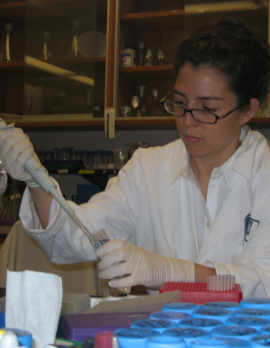Tying Up HIV With Tetherin
by Jeffrey Laurence, M.D. and Rowena Johnston, Ph.D.

Dr. Nolwenn Jouvenet in the lab of Dr. Paul Bieniasz at the Aaron Diamond AIDS Research Center in New York.
|
March 2009—Cells from virtually all forms of life have evolved the ability to suppress the growth of many viruses that would otherwise paralyze them. We’ve seen this process at work in the studies of several amfAR-funded investigators examining monkey counterparts of the human AIDS virus. Unfortunately, the anti-HIV capacity of such proteins in human cells is often stymied by specialized pieces of HIV itself.
amfAR-funded Krim Fellow Dr. Nolwenn Jouvenet, working in the lab of Dr. Paul Bieniasz at the Aaron Diamond AIDS Research Center in New York, wrote in the February issue of the Journal of Virology about a normal cell protein known as tetherin, newly discovered in their lab. Its production is stimulated by one of the very first natural anti-virus factors identified in humans: interferon. As its name implies, tetherin can, under the right conditions, target virus particles as they attempt to emerge from an infected cell, forming strings or tethers that prevent virus release. As an added benefit, those viruses don’t just sit there, captured. Rather, by a process yet to be fully understood, they are rapidly destroyed.
Tetherin is capable of at least partially suppressing several viruses harmful to humans, including the devastating Ebola virus, mini outbreaks of which have killed hundreds in Africa, including many physicians and nurses caring for those infected. Because tetherin is one part of an inborn or innate defense against many different types of viruses, it is unlikely to require interaction with specific pieces of HIV or other potential invaders. This is good news, as it implies that it would be very difficult for a virus to rapidly mutate to develop resistance to tetherin.
The bad news? HIV has a defense against tetherin: one of its minor proteins known as Vpu. Only AIDS viruses with defects in their Vpu, or monkey AIDS viruses that lack this component, are entangled by tetherin and end up being destroyed.
So, as in much of HIV research, every obstacle must be seen as an opportunity to develop new anti-HIV strategies. These new studies by Dr. Jouvenet and her associates will stimulate the search for new categories of compounds to block Vpu, which may permit yet another of our natural host defenses against viruses to work. Still, the ability of tetherin to block the final lifecycle stages not only of HIV but a number of other viruses means that these studies represent yet another example of AIDS research potentially benefiting those with other, understudied diseases.
Dr. Jeffrey Laurence is amfAR’s senior scientific consultant. Dr. Rowena Johnston is amfAR’s vice president of research.
Related articles:
The Broad Benefits of AIDS Research
Mathilde Krim Fellow Makes Breakthrough Finding
Broad-Spectrum Inhibition of Retroviral and Filoviral Particle Release by Tetherin
Tetherin inhibits retrovirus release and is antagonized by HIV-1 Vpu